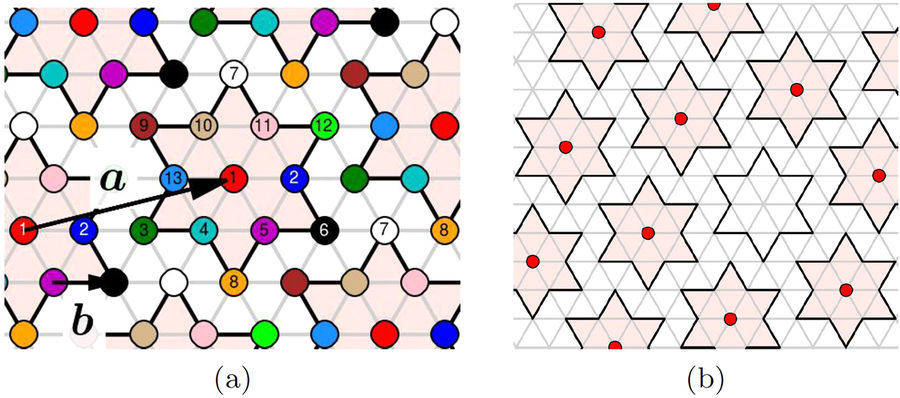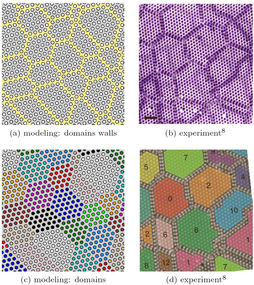NUST MISIS scientists have finally found out why a material that could potentially become the basis for ultra-fast memory in new computers is formed.
Professor Petr Karpov and Serguei Brazovskii, both researchers at NUST MISIS, have managed to develop a theory which explains the mechanism of the latent state formation in layered tantalum disulfide, one of the most promising materials for modern microelectronics.
The latent state of matter (which will be discussed further) was discovered by Serguei Brazovskii with a group of experimenters from Slovenia in 2014. The experiment that led to the beginning of the “boom” for the studies of layered materials lied in the fact that the tantalum disulfide sample, which was less than 100 nanometers big, was affected by an ultrashort laser (an electric pulse). The state of the material changed because of pulses in the irradiated area, and the sample became either a conductor of dielectrics or vice versa, depending on the experimenters’ wish. The switching even occurred in just one picosecond —a far quicker rate than in the “fastest” materials used as storage mediums in modern computers. That condition didn’t fade after exposure, but instead persisted. Accordingly, the material has become a potential candidate for the basis of the next generation of information data mediums.
Serguei Brazovskii is currently serving as the leading scientist of the “Theory of locally adjustable electronic states in layered materials” project at NUST MISIS, as well as working as a leading scientist at the University of Paris-Sud (Orsay, France) Laboratory of Theoretical Physics and Statistical Models.
Professor Petr Karpov, engineer at the NUST MISIS Department for Theoretical Physics and Quantum Technologies, explained the root of the matter, “The ‘boom’ in the study of layered tantalum disulfide happened, as well as a number of articles on this topic in different journals being published, after our colleagues from Slovenia discovered the latent state of the matter, unattainable in conventional (thermodynamic) phase transitions. However, most of these works were experimental, and the theory lagged behind. That is, the state could have been received but why did it turn out [that way]? What were the mechanisms of its formation? What its nature is in general, remained unclear. Why doesn’t the system return to its original state, continuing to remain in modified form indefinitely? In this article we tried to find the theoretical justification of the occurring processes”.
Tantalum disulfide belongs to a special group of conductor materials in which so-called charge-density waves are formed. This means that in addition to the natural peaks of electron density caused by the presence of an atom, there is also another periodicity that is several times greater than the distance between the adjacent atoms of the crystal lattice. In this case, the degree of that periodicity is the “root of thirteen”, so there is quite a large difference.
Picture A shows a layer of tantalum atoms. The period between the “superpeaks” is marked with a red arrow. The state of the different sites in the tantalum disulfide layer differ from each other in the fact that the maximum electron density is centered on tantalum atoms. The red ones show one state, while the “blue” and “white” ones show other states.
The work of NUST MISIS scientists consisted of constructing and studying a universal theoretical model that could describe the most important and intriguing property of the newly discovered state: the formation and transformation of nano-structural mosaics (pic. b). Some of the metal atoms fly out of the lattice after the processing of electrical impulses in the sample of layered tantalum disulfide, and that causes defects — charged vacancies in the electronic crystal.
However, instead of keeping a maximum distance from each other, the charges are “smeared” along the linear chains of tantalum atoms, forming boundaries of zones with different states of tantalum atoms. These “domains” then essentially chain up, connected to a global network. Manipulating these nanosets is the reason for the switching and memory effects observed in the material.
“We tried to find out why similar charges in such a structure do not repel, but, in fact, are attracted to each other. It turned out that this process is energetically more profitable than the maximum removal of positive charges from each other because the formation of fractional charged domain walls minimizes the charge of the constituent wall of atoms, which is why the domain system becomes more stable. This is completely confirmed by the experiment, and the whole crystal can be taken to such a state with a domain mosaic and globules dividing the walls”, — added Petr Karpov.
According to the scientists, thanks to the development of this theory, it is possible to confirm that the domain state of tantalum disulfide can be used for long-term storage and super-fast operation of information.
An article with the research results was published in Scientific Reports.





